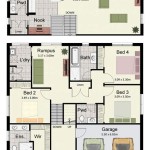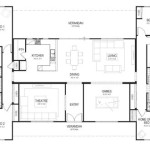Discover Space-Saving Charm: House Plans Below 2000 Sq Ft
The demand for smaller, more efficient homes is rapidly increasing. This trend is driven by various factors, including rising land costs, a desire for reduced environmental impact, and a focus on simpler living. Amidst this shift, house plans below 2000 square feet offer a compelling solution, providing a balance between comfortable living space and affordability. These plans necessitate innovative design strategies to maximize every square inch, resulting in homes that are both charming and functional. This article explores the key features, benefits, and considerations associated with choosing house plans under 2000 square feet.
Designing a home within a limited footprint requires careful planning and attention to detail. The goal is to create a space that feels larger than it actually is, offering comfortable living without sacrificing essential amenities. This is achieved through various architectural techniques and design principles, including open floor plans, strategic window placement, and efficient storage solutions. Understanding these elements is crucial for anyone considering a smaller home design.
Optimizing Space with Open Floor Plans
One of the most effective strategies for maximizing space in a small house plan is the implementation of an open floor plan. This design approach eliminates or minimizes walls between key living areas, such as the living room, dining room, and kitchen. By creating a seamless flow between these spaces, an open floor plan fosters a sense of spaciousness and promotes social interaction.
When implementing an open floor plan, it is important to define distinct zones within the larger space. This can be achieved through the use of furniture arrangements, area rugs, and changes in flooring materials. For example, a kitchen island can serve as a visual barrier between the kitchen and living room, while also providing additional counter space and seating. Similarly, a strategically placed area rug can define the living room area, creating a cozy and inviting atmosphere.
The benefits of an open floor plan extend beyond the perception of increased space. These layouts often improve natural light penetration, making the home feel brighter and more welcoming. They are also well-suited for entertaining guests, as they allow for easy movement and interaction between different areas. Furthermore, open floor plans can be adapted to suit various lifestyles, from young families to empty nesters.
However, open floor plans also present certain challenges. Noise transmission can be a concern, as sound travels more freely between open areas. Thoughtful material selection, such as incorporating sound-absorbing materials for ceilings and walls, can help mitigate this issue. Additionally, maintaining cleanliness and organization is crucial in an open floor plan, as clutter is more visible and can detract from the overall aesthetic.
Strategic Use of Natural Light and Windows
Natural light plays a crucial role in creating a sense of spaciousness and well-being within a home. In house plans below 2000 square feet, maximizing natural light is essential for making the space feel larger and more inviting. Strategic window placement is key to achieving this goal.
Considerations for window placement include the orientation of the house, the surrounding landscape, and the desired level of privacy. South-facing windows are ideal for capturing maximum sunlight during the day, while east-facing windows provide morning light and west-facing windows offer sunset views. However, excessive west-facing windows can also lead to overheating in the afternoon, so careful shading strategies may be necessary.
In addition to window orientation, window size and style also play a significant role. Large windows, such as picture windows and sliding glass doors, can bring in abundant natural light and offer expansive views of the outdoors. Skylights are another effective way to introduce natural light into interior spaces, particularly in areas where traditional windows are not feasible. Clerestory windows, which are placed high on walls, can also provide indirect light and ventilation.
The use of light-colored interior finishes, such as white or pastel walls, can further enhance the effect of natural light. These colors reflect light and help to brighten up the space. Mirrors can also be used strategically to reflect light and create the illusion of greater depth.
While natural light is highly desirable, it is important to consider the potential for unwanted heat gain and glare. Window treatments, such as curtains, blinds, and shades, can be used to control the amount of light entering the home and to provide privacy when needed. Low-E glass, which reduces heat transfer, is another effective option for managing sunlight and improving energy efficiency.
Incorporating Efficient Storage Solutions
In a small house, efficient storage is paramount. Clever storage solutions can help to minimize clutter and maximize usable space. This involves thinking creatively about how to utilize every nook and cranny, and incorporating built-in storage wherever possible.
Built-in storage solutions, such as bookshelves, cabinets, and drawers, are an excellent way to maximize vertical space and create a sense of order. These can be incorporated into walls, under stairs, and in other often-overlooked areas. Consider using floating shelves to create visual interest and provide storage without taking up floor space.
Multi-functional furniture is another key element of efficient storage. Sofas and beds with built-in storage compartments can provide valuable space for storing bedding, clothing, and other items. Ottomans with lift-up lids can serve as both seating and storage. Dining tables with drop-leaf extensions can be adjusted to accommodate different numbers of guests, saving space when not in use.
The kitchen is often a challenging area for storage, but there are many innovative solutions available. Vertical storage options, such as pantry pull-outs and spice racks, can help to maximize space in cabinets and drawers. Hanging pot racks can free up valuable counter space. The use of clear storage containers makes it easy to see what is inside, helping to prevent food waste and keep the kitchen organized.
In the bathroom, consider using recessed medicine cabinets and wall-mounted vanities to save space. Install shelves above the toilet to store toiletries and towels. Utilizing the space under the sink with shelving or pull-out drawers can also provide additional storage.
Beyond built-in storage and multi-functional furniture, it is important to adopt a minimalist approach to possessions. By decluttering regularly and getting rid of items that are no longer needed, you can reduce the amount of storage space required and simplify your life.
Choosing a house plan under 2000 square feet requires careful consideration of lifestyle and priorities. It is important to assess your needs and how you intend to use the space. For example, if you frequently entertain guests, you may want to prioritize an open floor plan and a well-equipped kitchen. If you work from home, you will need to ensure that there is a dedicated office space. If you have children, you will need to consider their need for play areas and bedrooms.
The selection of materials and finishes can also have a significant impact on the overall feel of a small home. Light-colored materials can help to brighten up the space and make it feel larger. Durable and low-maintenance materials are a good choice for high-traffic areas. Sustainable and eco-friendly materials can help to reduce the environmental impact of the home.
Ultimately, the key to success with a small house plan is to embrace creativity and innovation. By thinking outside the box and exploring different design options, you can create a home that is both functional and stylish, perfectly suited to your individual needs and preferences.
House plans below 2000 square feet are not just about downsizing; they are about right-sizing. They represent a conscious decision to prioritize quality over quantity, to focus on the essentials, and to create a home that is both comfortable and sustainable. With careful planning and thoughtful design, a small house can offer a rich and fulfilling living experience.

Best House Plan For 2000 Square Feet As Per Vastu

2000 Sq Ft House Plans Explore Best Selling Home Designs

Big Small Homes 2 200 Sq Ft House Plans Blog Eplans Com

Modern House Design How To Achieve Openness In

Big Small Homes 2 200 Sq Ft House Plans Blog Eplans Com

3 Bedroom House Plan Stylish Home Designs And Budgets In 2025

Small House Plans We Love Houseplans Blog Com

Big Small Homes 2 200 Sq Ft House Plans Blog Eplans Com

Home Designs Under 2500 Sqft Best House Plans Sq Ft Updated February 2024

Big Small Homes 2 200 Sq Ft House Plans Blog Eplans Com
Related Posts








